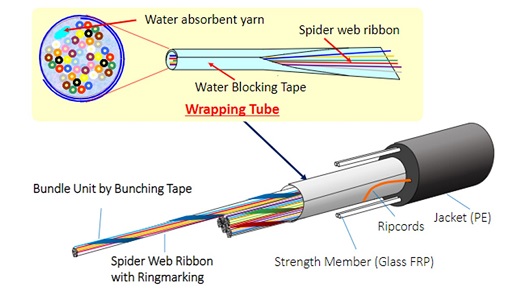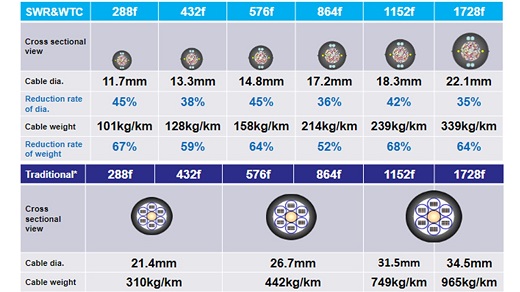The global demand for fibre optic cable has never been higher. Network operators throughout the world are adding more optical fibre to their networks than ever before. Fibre, which once was confined to high-capacity core network connections, is now used throughout operator networks and has become a key component in the delivery of access networks.
Deployment of fibre on such a scale is necessary to allow networks to handle the bandwidth demands of today and the future. These demands are driven by innovations such as Artificial Intelligence and the Internet of Things. Next generation access technologies such as 5G and FTTH/FTTB will be used to transport the data generated by applications that use these innovations. This is the driver for ubiquitous deployment of fibre rich networks.
However, it has been accepted now for many years that consumers are not willing to pay incrementally for their growing bandwidth demands. Therefore network operators must continuously search for innovations that allow them to reduce the cost of building networks while delivering ever increasing capacity and capabilities. A key investment metric for any network operator will be Total Cost of Ownership (TCO) – this should be a true measure of the cost of building any infrastructure and should include materials, labour and all associated miscellaneous costs such as permitting / wayleaves.
One of the biggest challenges that network owners must overcome is managing the cost of building the infrastructure in which fibre cable can be installed. The telecoms industry has invested billions of dollars developing and deploying technologies such as DWDM; this has added orders of magnitude to the data carrying capacity of individual optical fibres and therefore increased the economic lifetime of fibre cables. However, the physical capacity of pipes and ducts that carry fibre cable cannot be easily changed without repeating a very expensive dig/construction project. It is therefore very important that network owners optimise the utilisation of pipes and ducts at all times.
Whether deploying new duct routes or exploiting existing routes, consideration must be given to the fibre count of the cable that is deployed in order to drive a reduction in the total cost of ownership of the network and consequently the total cost per bit of data that passes over the network.
Hidden Value
When considering the budget for a new fibre cable project, it is easy for managers to focus on the unit price of the materials involved. However, it is more important that materials are selected to enable the project to achieve the best TCO for the customer. Studies have shown that cable, duct and associated materials represent less than 20% of the overall cost of a cable deployment project when this involves digging a new trench for the ducts. It is therefore important that managers focus on TCO when measuring value, rather than the unit cost of individual components.
Cost factors that influence TCO include; speed of deployment, cost of wayleaves and access permits, logistics, mobilisation time, and activation time. Any measures that can reduce these costs can drive significant improvement in TCO.
Alongside the huge expense of digging a new trench to facilitate a new fibre optic route, consideration must be given to project timescales and the disruptive nature of work. It is generally accepted that the costs and complexity of such projects increase exponentially with population density. Therefore the areas of greatest bandwidth demand are also the places where network construction costs are highest. Consequently, any existing infrastructure that was built for the purpose of carrying fibre cables in such areas is very valuable and operators faced with the challenge of delivering 5G, FTTH, IoT etc. should always consider maximising the capacity of these as part of their TCO and Return On Investment (ROI) calculations.
In summary, it is very expensive to build new duct routes so existing ducts are a valuable asset. Therefore, network operators should (i) always look to minimise the size of the cable they install to meet any specific fibre count requirement and leave the maximum possible room for future requirements and/or (ii) maximise the fibre count of the cable used during a project in order to deliver maximum long term capacity.
SpiderWeb Ribbon® A Fujikura Innovation
Ribbon fibre cables were first introduced over 30 years ago to increase fibre core counts in smaller diameter cables as many traditional cables were too large. Generally, ribbon cables are double-jacket single armoured cable designs, used in both underground and aerial fibre optic networks.
In order to minimize the construction cost of cable networks, reducing the diameter and weight of the cable is essential. Standard ribbon cable designs however, have now reached the point where further improvements in design will not deliver significant improvements in diameter or weight. In addition, standard ribbon cables are inflexible and difficult to handle.
To construct an efficient optical fibre network economically, Fujikura has successfully developed ultra-high density optical fibre cables with industry-leading diameter and weight characteristics. These cables contain a newly developed optical fibre ribbon, the SpiderWeb Ribbon® (SWR®) which is a bonded fibre ribbon technology that provides significant improvement in the fibre packing density. The SWR® technology consists of 12 fibres connected to each other by a periodic UV-curable resin bond. The periodic nature of the bond allows for the ribbon to be bunched and collapsed similarly to the expected movement of a bundle of loose fibres, while also allowing the ribbon to splice using mass fusion methods or to be divided into individual fibres for single fusion splicing.

When used with Wrapping Tube Cable™ (WTC™) technology, SWR® offers a significant reduction in overall cable diameter and weight when compared to traditional ribbon-based cable or loose tube fibre optic cable. Fujikura has used these innovations to develop a new range of ultra-high density fibre optic cables with performance characteristics that far exceed previous industry standards.

For example, a 288 fibre WTC™ cable has a cable diameter of 11.7mm and a weight of 101kg/km compared with 21.4mm and 310kg/km for the traditional equivalent. An 1152 fibre WTC™ cable has a cable diameter of 18.3mm and a weight of 239kg/km against 31.5mm and 749kg/km for the traditional ribbon design for that fibre count. The number of fibres that can be installed per duct is hugely increased: a 1728 fibre WTC™ will have a cable diameter similar to that of a 288 fibre traditional ribbon design. These size and weight savings translate directly to TCO and ROI benefits for customers.
Performance
Design of WTC™ has been carefully considered with speed and ease of installation as a priority. The core of the cable consists of SWR® which are ring marked and bundled depending on the cable fibre count. These bundles are wrapped with coloured binder tapes for easy identification and separation, the fibre is then covered with a longitudinal water blocking tape that creates the wrapping tube core. This wrapping tube core is sheathed with FRP strength members embedded within the jacket walls. Standard ripcords are placed 180-degrees apart underneath the sheath, and the locations are identified with a projection that is extruded into the sheath. This projection allows for the installer to locate the ripcord for safe access to a mid-span access point without damaging the cable core.
WTC™ is a completely dry structure allowing for efficient cable splicing and installation. There are no gels or buffer tubes for the installer to deal with, just clean and easily identifiable fibre bundles. It is also completely scalable depending on fibre count, allowing for a standardized design structure.
Mass fusion splicing techniques are used to perform splicing at cable joints and termination locations. This allows splicing of 12 fibre bundles rather than individual fibres thereby significantly reducing the time and resource required for splicing in any project. Field experience to date has shown splicing time reductions exceeding 60% in some cases.
The reduced size also means that longer lengths can fit on each reel, resulting in fewer splice points and therefore lower total splicing costs. The weight reduction has the greatest benefit when the cable pulling limits are reached. In North America, current methods use a combination of a breakaway swivel and monitoring of the pulling tension as a means of limiting the installation tension to acceptable strain limits. WTC™ can pull longer lengths before exceeding the maximum installation tension.
The weight and diameter savings also transfer to reduce costs for shipping, scrap, storage and preparation for the whole project compared to traditional designs for both single fibre and ribbon cable.
The combination of all of these advantages means that selecting WTC™ cable can drastically reduce the TCO of a cable installation project. Similarly, the increased fibre cable density significantly improves the ROI of duct investments as a result of increased duct utilisation. This is especially relevant for major metropolitan cities where the costs of building infrastructure can be extremely high.
Bringing super-fast public WiFi to NYC
Recent success of SWR® in conjunction with WTC™ technology is happening right now in New York City, where AFL (a subsidiary of the Fujikura group) has been able to tangibly substantiate the value and savings associated with the key elements noted above.
In 2014, the New York City Administration issued a competitive request for proposal (RFP) to re-purpose payphone infrastructure with free WiFi, phone calls and advertising. A large consortium group submitted a proposal for a WiFi project and was chosen for its innovative and community-first approach. They were awarded the 12-year franchise contract to provide the new infrastructure for the communication services. This large consortium group is an organisation of experts in technology, media, user experience and connectivity that includes Intersection, Qualcomm and CIVIQ “Smartscapes.”
The main backbone for this fibre system is the AFL Wrapping Tube Cable™ (WTC™) and SpiderWeb Ribbon® (SWR®). WTC™ offers another significant cost reduction, in that it allows longer cable lengths – up to 30% longer. These longer cable lengths provided savings on reel-end splicing costs by allowing the cable runs to go further without the need for a splice. Additionally, mid-cable access splicing times were greatly improved through reduced cable preparation time and faster mass fusion splicing time. WTC™ can realise even more savings due to the installation improvements which come as a result of the cable handling itself. The smaller diameter and lighter weight allow for faster installation than the pulling of traditional cables, as well as accommodating the use of standard installation apparatus and methods when pulling the ultra-high fibre count cable.
This brought in free, super-fast WiFi across New York City with a network of at least 7,500 Link Kiosks. Each gigabit Link is powered by an all-new, purpose-built fibre optic network that delivers speeds up to 100 times faster than average public WiFi. The consortium group is making a significant investment to build hundreds of miles of new fibre optic cable that will deliver gigabit connectivity to Links in all five boroughs. Each link has the capacity to support hundreds of WiFi users simultaneously, and the consortium group will also bring gigabit service to an indoor public centre in each borough for New Yorkers to access high speed service wherever they live.
An innovative technology network
The high-speed pathway for the New York WiFi project is being built by the operator of a dark fibre network in New York City, which provides backhaul fibre and passive wavelength connectivity to all major co-location facilities throughout the New York metro area, as well as to macro sites, small cells and WiFi nodes. WiFi kiosks are also now interconnected with a number of AFL fibre optic technologies, which provide the high-speed pathway for connectivity of the gigabit system. Each kiosk provides connection to any enabled wireless device for access to internet, emergency 911/411 services, voice calling and other information services.
During installation, whenever slack is required or when the installation constraints force bi-directional pulls, WTC™ can quickly coil into figure-8 coils and transition to the next pulling stage. The smaller diameter and lower cable weight ensured that the cable could be coiled into large figure-8 storage points then quickly pulled in the opposite direction, maximising efficiency of the network.
With the use of Fujikura’s WTC™, the network could pull a single 1,728 fibre WTC™ rather than two 864 fibre cables and eliminate one 50mm sub-duct. This resulted in a significant cost reduction per year for the first phase of this project alone. The second phase of the project is currently underway.
Looking ahead to innovative ribbon technologies
Historically, there have been many limitations associated with the application and design of loose tube and ribbon fibre optic cables, with some struggling to get the maximum potential from this new technology. Fibre is often taken for granted, due to its mass use across a number of industries, including public safety, medical, defence and government. This presumptuous attitude to the reliability of traditional technologies can be catastrophic, as many become complacent to the technology and unprepared for disconnect or the future The SWR®, when used in combination with WTC™, provides the ultra-high density critical for ease of use, reliability and cost that the industry has been waiting for.

